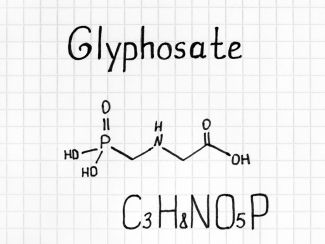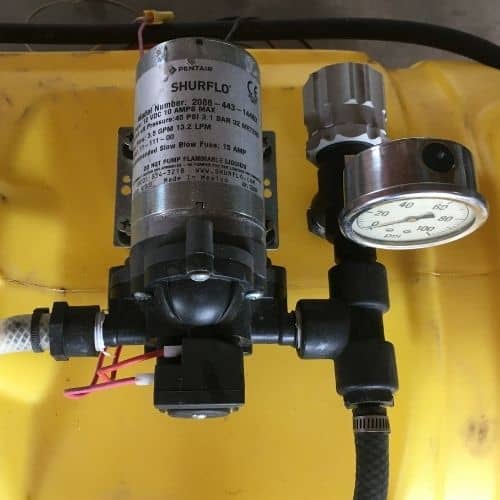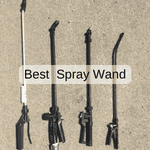Roundup herbicide is a popular weed killer. The active ingredient is glyphosate, widely used for weed control in maintenance, construction, forestry, and agriculture. It is a non-selective herbicide, meaning it will kill just about all plants including grass. It is available in both ready-to-use and concentrate forms so understanding the proper dilution process is crucial for effective and safe application. In this article, we will answer common questions related to diluting Roundup, including the process for both ready-to-use and concentrate and appropriate mixing ratios.
Can Roundup Be Diluted With Water?
Yes, water is commonly used to dilute Roundup herbicide. Diluting concentrated Roundup with water is necessary to use it in a sprayer. Otherwise, it would be nearly impossible to apply Roundup over the entire surface of a plant as the amount needed would be so low. You would essentially be putting a few drops on a plant, and it needs to cover the surface of the ground or plant more thoroughly.
If you have premixed Roundup, like Roundup Ready-to-Use or Pump N’ Go, it is not necessary to dilute it with water.
Roundup & Water Mixing Ratios for Different Applications:
| Application | Solution % | Mix Ratio |
|---|---|---|
| Spot Spray – Handheld & Backpack Sprayers | 1.5 percent solution | 2 ounces Roundup per 1 Gallon of water |
| Broadcast/Boom Sprayers | 4 – 7 percent solution | 5-9 ounces per gallon of water |
| Weed whips/Weed ropes | 25-70 percent solution | 32 ounces of Roundup to 96 ounces of water, or 90 ounces o Roundup to 38 ounces of water |
| Cut Stump Treatment or Injection in Woody Plants | 50-100 % solutions | 1 to 1 with water or all Roundup |
If you are going to be spraying roundup with a boom sprayer, it is important to note that the mix ratio is different than your application rate. Application rate is the amount of liquid you need your sprayer to spray over a given area. For more detailed information about application rates and how to calibrate your sprayer refer to this guide where we break down the different sprayer calibration formulas.

How Do You Dilute Roundup Concentrate?
Diluting Roundup Concentrate requires that you adhere to the mixing guidelines on the label. The amount of Roundup to water in your sprayer depends on the type of target weed, growth stage, and how severely established is your target weed.
- Step 1: Gather the needed equipment, including a clean and labeled mixing container (this might be your sprayer if diluting directly in the tank), measuring container, and appropriate PPE (gloves, goggles, and long-sleeved clothing).
- Step 2: Determine the desired ratio for your application. This will be based on the specific spraying task and the size/severity of the weed infestation.
- Step 3: Add the required amount of water to the mixing container before the Roundup. This avoids foaming.
- Step 4: Measure the Roundup Concentrate using the measuring cup or container, and add it to the water in the mixing container.
- Step 5: Mix the contents thoroughly to create a uniform solution. If you are mixing in a hand pump or backpack sprayer, you can agitate the sprayer by gently shaking it or in the case of a backpack sprayer, walking around will provide some agitation.
It is important to note that there are generic glyphosate products that will be mixed and diluted the same as the brand name Roundup products. Just be sure to check the label to see what percent of the solution is glyphosate.

Can Roundup Ready-to-Use be diluted?
Yes, Roundup Ready-to-Use can be diluted. Although the purpose of the premixed product is to allow you to spray immediately and not worry about mixing the correct ratio. However, diluting the premixed product allows you to cover a larger area more economically.
Diluting the ready-to-use formula will mean that if all other things remain the same (nozzle size, spraying speed, etc.), you will be applying less Roundup over the same area. This means that the spray mixture might be less effective.
Premixed Roundup is usually 2% glyphosate. You would want to dilute this if the rate you need for the weeds you want to kill is lower than 2% or if you were wanting to see if a lower rate would be effective. This could save money, but with the over-application of Roundup, some weeds may become resistant to the herbicide. Diluting your Roundup could help to limit the resistance over time if you plan to spray Roundup year after year.
It is important to note that If you are going to dilute the mixture and are not sure if the lower rate will be effective you may end up needing to respray.
There are Roundup products labeled concentrate, but these are not 100% glyphosate. They can range from about 18% to 48% solution or more, so it is vital to check the label on any jug before you dilute or mix it.
How to Dilute Roundup Ready-to-Use
Premixed Roundup is usually a 2% solution. So if you mix 1 part water and one part pre-mixed Roundup, you now have a mixture that is 1% Roundup. So when you are diluting your ready-to-use Roundup mix, it is important that you keep track of the amount of water you add in order to know how much active ingredient (glyphosate) is in your solution.
Concentrated Roundup recommends a 1.5% solution (1.5% Roundup, 98.5% water) for weeds when using hand-held/backpack sprayers. So be careful not to mix your solution too weak or you may need to cover everything with your sprayer again.
The mixing process is simple. You can use any poly, stainless steel, or fiberglass container that is clean. Add the fresh water first then slowly add the Roundup to avoid foaming. The pre-mixed Roundups will not foam much, but more concentrated mixes will.
How do you use Roundup Ready-to-Use?
Roundup Ready-to-Use is a pre-mixed herbicide for eliminating just about any weed even grass. It is a product that is intended to be easily used without mixing, handling, or measuring the herbicide. The solution can be sprayed right out of the container.
There are different versions of the Roundup Ready-to-Use family:
- Jugs with a battery-operated spray wand
- Pump and spray jugs
- Re-fill jugs of pre-mixed Roundup herbicide
Each one is simple to use, you can pump the handle and then pull the trigger on the sprayer. In the case of the battery-operated wands, pull the trigger and begin applying the liquid where you desire.
RELATED: Fixing a Roundup Ready-to-Use Sprayer
Roundup Ready-to-Use is not intended for broadcast spraying over an entire lawn as it is low volume, but more importantly, glyphosate, the active ingredient in Roundup, kills grass. This product is meant to control weeds in driveways, concrete cracks, rock beds, around buildings, fences, etc.
When spot spraying spray the targeted weed until at least 50 percent of the surface of the plant is covered. If this is your first time using Roundup, and you have more questions please check out this article that covers frequently asked questions about using Roundup.
Here are some other tips for using Roundup Ready-to-Use:
- Use protective gear, including gloves, goggles, and long-sleeved clothing.
- Shake the container well before use
- Aim the spray nozzle at the weeds, holding it about 12 inches away
- Spray weeds evenly, cover all the leaves and stems thoroughly
- Avoid spraying on windy days to prevent drift onto desirable plants
- Allow time for the herbicide to work. Weeds typically show signs of wilting and browning within a few days.
Safety precautions when using Roundup:
- Always read and follow the product label instructions and warnings
- Keep children and pets away until the spray has dried completely.
- Store Roundup and its diluted solutions out of reach of children and pets
- If skin and eyes are exposed, rinse thoroughly with water.
Conclusion
Roundup is an effective product. Mixing and using it correctly is important. If you are looking for more information about the types of sprayers to use with Roundup, be sure to check out this beginner’s guide to selecting a sprayer.
What are your thoughts? Have your experiences been different? Do you have more questions? Let us know below!





